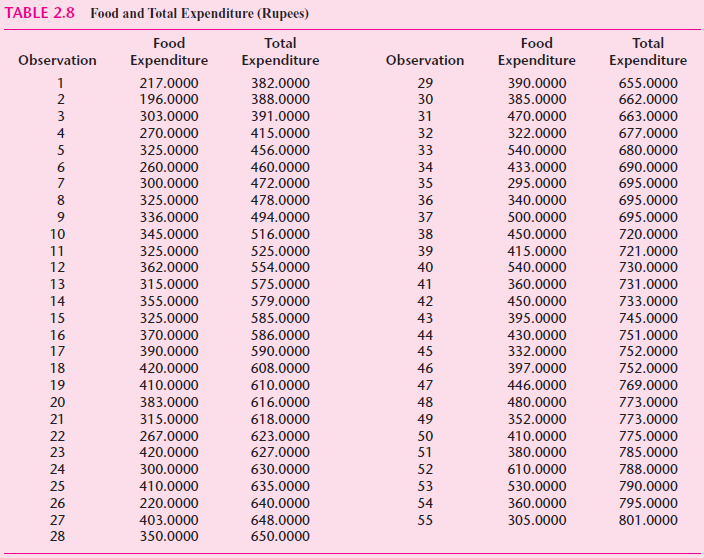Question:
Table 2.8 gives data on expenditure on food and total expenditure, measured in rupees, for a sample of 55 rural households from India. (In early 2000, a U.S. dollar was about 40 Indian rupees.)
a. Plot the data, using the vertical axis for expenditure on food and the horizontal axis for total expenditure, and sketch a regression line through the scatter points.
b. What broad conclusions can you draw from this example?
c. A priori, would you expect expenditure on food to increase linearly as total expenditure increases regardless of the level of total expenditure? Why or why not? You can use total expenditure as a proxy for total income.

Transcribed Image Text:
TABLE 2.8 Food and Total Expenditure (Rupees) Food Expenditure Total Expenditure Food Total Observation Observation Expenditure Expenditure 217.0000 382.0000 388.0000 29 390.0000 655.0000 2 196.0000 30 385.0000 662.0000 470.0000 663.0000 3 303.0000 391.0000 31 4 270.0000 415.0000 32 322.0000 677.0000 456.0000 460.0000 472.0000 5 325.0000 33 540.0000 680.0000 260.0000 34 433.0000 690.0000 300.0000 35 295.0000 695.0000 325.0000 478.0000 36 340.0000 695.0000 336.0000 494.0000 500.0000 695.0000 37 10 345.0000 516.0000 38 450.0000 720.0000 325.0000 362.0000 11 525.0000 39 415.0000 721.0000 554.0000 12 40 540.0000 730.0000 13 315.0000 575.0000 41 360.0000 731.0000 14 355.0000 579.0000 42 450.0000 733.0000 15 325.0000 585.0000 43 395.0000 745.0000 370.0000 390.0000 751.0000 752.0000 16 586.0000 44 430.0000 332.0000 17 590.0000 45 608.0000 610.0000 18 420.0000 46 397.0000 752.0000 769.0000 19 410.0000 47 446.0000 20 383.0000 616.0000 48 480.0000 773.0000 21 315.0000 618.0000 49 352.0000 773.0000 22 267.0000 623.0000 50 410.0000 775.0000 420.0000 23 627.0000 51 380.0000 785.0000 300.0000 630.0000 610.0000 788.0000 790.0000 24 52 25 410.0000 635.0000 53 530.0000 360.0000 26 220.0000 640.0000 54 795.0000 27 403.0000 648.0000 55 305.0000 801.0000 28 350.0000 650.0000








